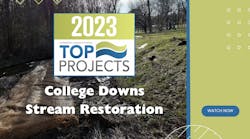Kim Patak is PE, CFM, ENV SP, associate and storm water management project manager for Freese and Nichols Inc. Patak can be reached at [email protected].
undefinedFrom the Gulf Coast to the New Mexico desert, communities in diverse settings are increasingly recognizing the importance of building green storm water infrastructure into their futures. Large and small communities alike are embracing practices adapted to their size and geography. And they’re showing how going green for storm water resilience offers a sound investment that is affordable and compatible with development.
Adopting a green infrastructure mindset can be as targeted as setting storm drain criteria for a new roadway or as broad as adding low-impact options to local codes.
The benefits extend across the community, whether it’s a beachfront location, a major metropolitan area or a largely arid desert town: cooler air, cleaner water, less property damage from heavy rains, responsible use of natural resources, and ultimately, a more appealing environment in which to live and work.
These examples show the diversity of approaches being adopted by some cities across the southern United States.
San Antonio, Texas
The seventh-largest U.S. city, San Antonio in Central Texas is home to almost 1.6 million people. The Brooks Development on the city’s south side provides an example of San Antonio’s creative growth and development efforts. When Brooks Air Force Base closed in 2011, the site was repurposed as a 1,308-acre master-planned community of homes, businesses and schools.
The Brooks area is bound by the San Antonio River and Salado Creek, both of which have been designated “impaired” for recreational use because of high E. coli levels. As a result, the site presents an opportunity to incorporate green infrastructure in ways that could contribute to cleaning the waterways.
To promote sustainability goals as Brooks continues developing, the San Antonio River Authority worked with a team of consultants to produce a guidebook that demonstrates how low-impact development (LID) techniques can be adopted within the complex. The manual includes a variety of detailed tools, including:
- A toolkit explaining how LID tools work, the benefits they bring to the community, design criteria involved and their typical construction costs;
- Case studies that show how to adjust proposed plans for specific Brooks sites to add green features, such as bioretention basins, landscaping, bioswales and permeable paving — and at what cost; and
- A primer on ecosystem tools, such as native plantings, noise mitigation berms, trees and green walls, that can be incorporated into existing and new developments and yield a multitude of benefits for a community when added where they have the highest impact.
While the guidelines are optional, rather than laying out new code requirements, they provide the kind of roadmap that helps answer the questions “Why do it?” and “What will it take?”
Norman, Oklahoma
A growing city of 120,000 just south of Oklahoma City, Norman is home to the University of Oklahoma and to residents who are helping drive a focus on wide-ranging quality of life improvements.
The city is rewriting its engineering design criteria and exploring how to add green storm water infrastructure (GSI) criteria and other low-impact development principles into the update. The revisions are intended to promote consistency in design, review and construction and to remove obstacles to adopting green infrastructure, such as standards that do not make them an option or conflicting procedures that act as an impediment. A key city goal is to encourage developers to incorporate GSI to help with removing pollutants from storm water runoff.
The city worked with a consultant to complete an assessment of existing technical manuals and codes in early 2021 to catalog the revisions needed. The report recommended to:
- Adopt GSI incentives for residential, commercial and industrial projects;
- Develop a program to educate the public about green infrastructure and its benefits; and
- Promote GSI and water conservation through parking and landscape requirements.
The final criteria, when adopted, will address responsibility for maintaining green features, such as rain gardens, and mechanisms for holding property owners accountable.
Port Aransas, Texas
This beach town of 4,000 residents on Mustang Island on the Texas Gulf Coast suffered an estimated $1 billion in damages when Hurricane Harvey hit in 2017. That storm destroyed city infrastructure including police, courts and emergency medical services buildings and municipal vehicle fleets.
City leaders recognize the hazards of brutal storms but also from lesser storms that cause localized flooding. Officials and staff also increasingly worry about runoff carrying pollution and debris into coastal waters and marine habitats that are critical to tourism.
The city is developing a storm water management plan, bringing together stakeholders including developers, homeowners, RV park owners and environmental groups. The plan envisions new requirements that cover a range of approaches, such as:
- Putting stamps on drainage structures and manhole covers to educate the public on where water drains to;
- Starting a recurring event for hazardous waste/bulk collection to discourage dumping;
- Amending the landscaping ordinance to offer incentives for adding green storm water; infrastructure and preserving sensitive areas, such as wetlands; and
- Initiating recycling and banning plastic foam products (such as Styrofoam) on the beaches.
The management plan is primarily funded through a grant from the Texas General Land Office. Port Aransas is not yet subject to state restrictions on storm water discharges from small municipal separate storm sewer systems, but officials expect that to happen soon because of population growth, and they want to get ahead of compliance requirements.
Key in enacting a storm water management plan is public input and education about the area’s vested economic interest in a resilient coastline and clean water. The plan is built around a five-year timetable that starts with a focus on creating incentives and gradually moving toward regulation. The goal is to turn residents into ambassadors and advocates for protecting natural resources.
Las Cruces, New Mexico
The second-largest city in New Mexico, with 103,500 residents, Las Cruces is surrounded by distinctive natural features: the Chihuahuan Desert, the Mesilla Basin Aquifer, the Organ Mountains and the Rio Grande. The city is less than an hour drive from both El Paso, the farthest-west city in Texas, and Ciudad Juarez in Mexico.
Las Cruces serves a diverse population that includes longtime locals, students attending New Mexico State University and Doña Ana Community College, retirees and employees of nearby White Sands Missile Range and Fort Bliss, a U.S. Army installation. The area also attracts tourists to the Organ Mountain-Desert Peaks National Monument, historic Old Mesilla and White Sands National Park.
The city boasts 350 days of sunshine each year — and only an average of 8.5 inches of rain — so both water conservation and storm water management are vital. Flash floods wash away sand and water but also send litter, sediment and street pollutants into waterways.
The city was New Mexico’s first STAR Community, recognized for sustainability efforts that include reducing the number of below-code homes located in high-flood risk areas. Now, the city is undertaking a significant update of its Land Development Code to implement the recently adopted comprehensive plan Elevate Las Cruces.
This code is being crafted to further goals, such as including more landscaping that features native and drought-tolerant plants around commercial, residential and public buildings and community gathering areas. Xeriscaping is well-suited to the area’s climate and has been adopted across the city. The updated code might require this technique for all new development. The code also will provide tools for adopting other storm water management techniques and green street design features to reduce harmful runoff and lower consumption of scarce resources.
Key Takeaways
Commitment from local leaders is essential for green infrastructure to take root; so is public education to build support and understanding among residents, businesses and developers.
Many communities are taking a gradual approach, relying initially on incentives instead of mandates. But even incremental adoption of the right tools, in the right settings, can provide long-term benefits to a community’s health and future.






